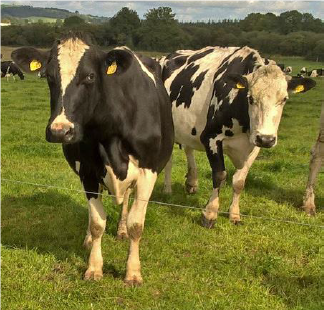Be on the Lookout for Summer Mastitis
19 June 2025With the exceptional weather so far this spring and early summer, we need to be vigilant for cases of summer mastitis. This disease is normally seen in the warmer summer months of July through to September when fly populations are at their peak.
Summer mastitis affects the non-lactating mammary gland, so grazing dry cows and heifers are more at risk than the milking herd. The main vector for disease transmission between quarters and animals is the sheep head fly, and the bacteria responsible are most commonly Trueperella pyogenes and Streptococcus dysgalactiae. Summer mastitis tends to occur in the same fields each year on affected farms, and usually in fields near a water source and those shaded with trees or bushes.
Clinical signs of the disease may be mild, such as blind quarters, but in more serious cases, (if not treated early enough), the infected quarter can burst, spreading the infection to other quarters. Once infected the quarter is unlikely to recover.
Symptoms
The symptoms of summer mastitis include:
- Swollen teats, both in length and diameter, for up to a week before seeing clinical signs of sickness.
- A swollen and hard infected quarter.
- A very painful quarter where the secretion will be thick and clotted.
- In severe cases, animals will have a high temperature.
- Lots of flies will be seen around the infected teat causing irritation and kicking.
- Affected animals may isolate themselves from the herd, showing stiffness and reluctance to walk.
- Rapid weight loss.
- Abortion is not common but may occur up to a fortnight after the initial infection.
Calves born from affected cows may be weak and are more at risk of disease unless given good quality colostrum from a healthy cow. The calf should not receive its mother’s colostrum. If colostrum is not available from another cow, use an artificial colostrum replacer.
Case of summer mastitis left hind quarter (note swollen appearance)

Photo credit: SRUC Veterinary Services
Best practice is for affected animals to be housed to prevent flies spreading the infection to healthy animals. The infected quarter(s) should be regularly stripped out, even up to several times a day for the first few days, to reduce the likelihood of abscesses bursting through the side of the udder. If possible, dispose of the infected pus safely and do not leave it on the ground. Penicillin-based antibiotics should be used to treat the infection, along with an anti-inflammatory to reduce pain and swelling.
Prevention
Several measures can be taken to help prevent the disease. These include treatments to help seal the teat canal and reducing exposure to flies:
- External teat sealants e.g. topical solutions or micropore tape. The downside to these is that they need to be reapplied regularly.
- Pour-on treatments containing permethrin can be used around the udder where they are more likely to offer protection compared to pouring on the backs of cattle, or ear fly tags. They should be reapplied every 4 weeks.
- If possible, avoid grazing heifers or dry cows in fields that provide cover for flies i.e. in fields with trees, bushes or high weeds and fields with or near to water sources.
- Animals at high risk should be housed. This includes those with teat end damage, warts and hyperkeratosis.
Consult your vet regarding the use of intramammary antibiotics at drying off or even for pre-calving heifers. Reinfusion after a month may be required (depending on the calving date and withdrawal period). Good hygiene for antibiotic infusion and teat sealant use is critical. Internal teat sealants can also be used. There may be a case for stopping selective dry cow therapy during the months when the risk is high, especially if summer mastitis is a regular occurrence on the farm.
Sign up to the FAS newsletter
Receive updates on news, events and publications from Scotland’s Farm Advisory Service

